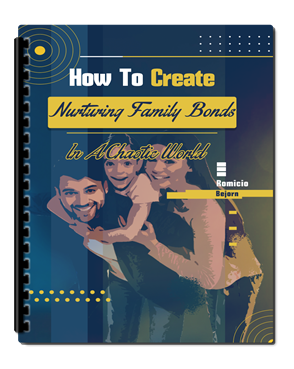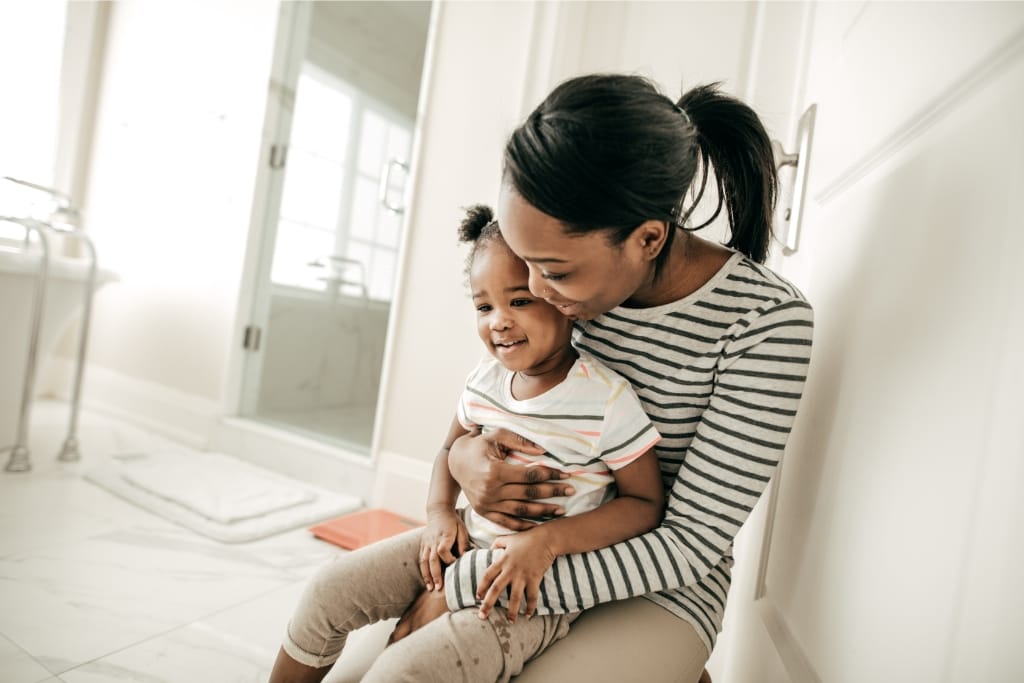Potty training is a significant milestone that marks a child's growing independence, but it can also present unique challenges.
Achieving success in this area requires a blend of patience, consistency, and empathy.
If you're feeling overwhelmed or uncertain about how to begin, take heart!
We have compiled 10 invaluable tips to help ease the way for both you and your little one, making this essential transition as smooth as possible.
1)) Start At The Right Time
Every child is different when it comes to readiness for potty training.
Look for signs that your child is ready, such as staying dry for longer periods, showing interest in the toilet, or expressing discomfort with dirty diapers.
Example: Recognizing Readiness
Imagine you've noticed that your two-and-a-half-year-old, Mia, has been waking up with a dry diaper after her afternoon nap for the past week.
She's started to follow you into the bathroom and shows a keen interest in what's happening.
She also frowns and gestures unhappily when she's wearing a soiled diaper.
These are all strong indicators that Mia might be ready to start potty training.
Seeing these signs, you decide to introduce the potty to her routine gently, praising her curiosity and explaining the process in simple terms to make her comfortable with the idea.
Starting potty training at the right time revolves around understanding your child's cues and readiness.
By recognizing these indicators and introducing the process with patience and encouragement, you set a positive tone for the entire potty training journey.
Remember, each child progresses at their own pace, so celebrate small victories along the way.
2)) Create A Routine
Establish a consistent potty routine by taking your child to the bathroom at regular intervals throughout the day.
This will help them get used to using the toilet and decrease accidents.
Tips for Establishing a Potty Routine:
- Set Regular Times: Schedule specific times during the day for potty breaks, such as after meals, before naps, and before bedtime. Consistency helps reinforce the habit.
- Use Visual Aids: Implement a potty chart where your child can place stickers every time they use the toilet. This visual reinforcement can motivate and help them understand the routine.
- Positive Reinforcement: Offer praise and small rewards for following the routine and using the potty, such as a special storytime or a small treat. Positive reinforcement encourages continued participation and effort.
Establishing a consistent potty routine is key to helping your child adapt to using the toilet.
By setting regular times, using visual aids, and providing positive reinforcement, you create a structured and encouraging environment that makes potty training a more manageable and rewarding experience for both you and your child.
3)) Use Positive Reinforcement
Encourage your child with praise, hugs, or small rewards when they successfully use the potty.
Positive reinforcement can go a long way in motivating your child to continue their potty training journey.
Example: Celebrating Success
Consider your three-year-old son, Jack, who has just used the potty for the first time. He beams with pride as he runs to tell you.
In response, you give him a big hug and say, "Great job, Jack! I'm so proud of you!"
You add a star sticker to his potty chart and let him choose a fun activity to do together, like reading his favorite book.
This positive reinforcement not only boosts Jack's confidence but also makes him eager to repeat the experience, knowing that his efforts are celebrated and acknowledged.
Using positive reinforcement during potty training helps build your child's confidence and enthusiasm for the process.
By celebrating their successes with praise, hugs, or small rewards, you create a supportive atmosphere that encourages your child to continue progressing.
This approach not only makes potty training more enjoyable but also strengthens the bond between you and your child as you navigate this important milestone together.
4)) Be Patient And Understanding
Potty training takes time and accidents are bound to happen. Stay calm and supportive during setbacks, and avoid scolding or shaming your child for accidents.
Tips for Being Patient and Understanding:
- Stay Calm During Accidents: Remain calm and composed when accidents occur. Reassure your child that accidents are a normal part of learning and encourage them to keep trying.
- Offer Comfort and Support: Provide emotional support by comforting your child with kind words and a gentle hug. Let them know it's okay and that you believe in their ability to succeed.
- Practice Empathy: Understand that potty training can be challenging and frustrating for your child. Listen to their concerns and frustrations with empathy, and try to see the situation from their perspective to provide the necessary support and reassurance.
Being patient and understanding is essential for a successful potty training experience.
By staying calm during accidents, offering comfort and support, and practicing empathy, you can help your child feel secure and motivated as they navigate this new phase.
Your patience will foster a positive learning environment, making the journey smoother and more enjoyable for both you and your child.
5)) Make It Fun
Turn potty training into a fun and engaging experience by using colorful stickers, special underwear, or books about using the toilet.
Keeping things light-hearted can make the process more enjoyable for both you and your child.
Tips for Making Potty Training Fun:
- Use Fun Tools: Introduce colorful stickers, special underwear with favorite characters, or interactive potty training books. These tools can make the experience exciting and engaging for your child.
- Create Fun Games: Turn potty breaks into mini-games, such as aiming at targets in the toilet for boys or timing how long your child can wait before using the bathroom. These playful elements can make the process more enjoyable.
- Sing Songs and Read Stories: Sing silly songs or read stories about potty training while your child is on the toilet. This not only keeps them entertained but also helps them associate potty time with positive and fun experiences.
Making potty training fun can transform the process into an enjoyable and positive experience for your child.
Utilizing fun tools, creating games, and incorporating songs and stories can keep your child engaged and eager to participate.
By maintaining a light-hearted and playful approach, you can help your child develop a positive attitude towards potty training, making the journey smoother and more successful for both of you.
6)) Let Them Choose Their Supplies
Allow your child to pick out their own potty seat or step stool to make them feel more involved in the process.
Giving them some control can boost their confidence and independence.
Tips for Letting Them Choose Their Supplies:
- Take Them Shopping: Bring your child along to pick out their potty seat or step stool. Let them choose designs, colors, or characters they like to make the item more appealing to them.
- Offer Options: Present a few pre-selected choices that are suitable and safe. This way, your child feels involved while ensuring the supplies are practical for their needs.
- Encourage Ownership: When your child selects their supplies, refer to them as "Jack's special potty" or "Sophie's step stool" to create a sense of ownership and pride.
- Discuss Their Preferences: Engage in a conversation about what features they would like in their potty supplies, such as stability, height, or comfort, to ensure they're excited about using them.
- Celebrate the Selection: Make a big deal out of their choice by celebrating it together. For example, take a picture of your child with their new potty supplies and display it proudly.
Allowing your child to choose their potty supplies can significantly enhance their involvement and enthusiasm for potty training.
By taking them shopping, offering options, encouraging ownership, discussing their preferences, and celebrating their selection, you empower your child and boost their confidence.
This sense of control and pride in their choices can lead to a more positive and successful potty training experience.
7)) Dress For Success
Choose clothing that is easy for your child to manage on their own when using the potty.
Avoid complicated buttons or snaps that may slow down the process when they need to go quickly.
Tips for Dressing for Success:
- Opt for Elastic Waistbands: Choose pants and underwear with elastic waistbands that your child can easily pull up and down without assistance. This will foster independence and speed up the process.
- Avoid Complicated Fasteners: Steer clear of clothing with complicated buttons, snaps, or zippers that can be challenging for your child to manage when they're in a hurry.
- Use Pull-Ups: During the early stages of potty training, consider using pull-ups instead of regular diapers. Pull-ups are designed to mimic underwear but are easier for a child to manage.
- Dress in Layers: Layering can be practical; if your child has an accident, it’s easier to change a lower layer without having to deal with multiple pieces of complicated clothing.
Dressing your child in easy-to-manage clothing can greatly facilitate the potty training process.
By choosing elastic waistbands, avoiding complicated fasteners, using pull-ups, and dressing in layers, you ensure that your child feels more independent and can quickly and efficiently use the potty.
These practical clothing choices can help reduce frustration and make potty training smoother for both you and your child.
8)) Set realistic Expectations
Every child learns at their own pace. Don't compare your child's progress to others or put pressure on them to achieve milestones by a certain age.
Example of Setting Realistic Expectations:
Imagine your friend tells you that their child was fully potty trained by age two, but your child is now two and a half and still struggling with the process.
Instead of feeling discouraged, remember that each child is unique and develops at their own pace.
For instance, while your friend's child may have mastered potty training early, your child might excel in another area, such as language skills or social interactions.
Setting realistic expectations for your child's potty training journey is essential for their confidence and peace of mind.
By understanding that each child progresses at their own pace, avoiding comparisons, and celebrating small victories, you create a nurturing and supportive environment.
This approach not only reduces pressure but also helps foster a positive learning experience for your child.
9)) Consistency Is Key
Stick with your potty training plan even when it feels like progress is slow. Consistency in routines and expectations will help reinforce good habits over time.
Tips for Maintaining Consistency:
- Establish a Routine: Create a daily schedule that includes regular potty breaks. Consistency in timing helps your child understand and anticipate when it's time to use the potty.
- Use Consistent Language: Choose specific words or phrases related to potty training and use them consistently. This helps your child make connections and understand what's expected.
- Stay Patient and Positive: Even if progress seems slow, maintain a positive attitude and consistently encourage your child. Celebrations of small successes will reinforce their efforts and build confidence.
Consistency is key in helping your child develop good potty training habits.
By establishing a routine, using consistent language, and staying patient and positive, you reinforce the importance of using the potty regularly.
This steady approach fosters understanding and confidence, leading to a more rewarding and effective potty training experience for your child.
10)) Celebrate Successes
When your child reaches a major milestone like using the toilet independently or staying dry all day, celebrate their achievement with a special treat or outing.
Recognizing their hard work will encourage them to continue making progress.
Example of Celebrating Successes:
Suppose your child has been diligently practicing potty training and finally manages to go the entire day without an accident.
To celebrate this significant achievement, you might take them to their favorite park for some playtime or organize a small family celebration at home.
You could also give them a special sticker for their potty training chart, followed by a congratulatory hug and words of encouragement.
This kind of positive reinforcement not only acknowledges their effort but also motivates them to continue striving towards their potty training goals.
Celebrating your child's successes during potty training is crucial for maintaining their motivation and confidence.
By acknowledging and rewarding their achievements, you create a positive and encouraging atmosphere that reinforces their efforts and progress.
This positive feedback loop inspires your child to keep striving towards their potty training goals, making the journey more enjoyable and successful for both of you.
Conclusion
Potty training is a crucial developmental milestone that can seem daunting at first, but with the right approach, it can be a smooth and even enjoyable experience for both you and your child.
By following these 10 practical tips, you can foster a positive and supportive environment that encourages your child’s independence and self-confidence.
Patience and consistency are essential, and celebrating small victories will create a sense of accomplishment for your little one.
Approach each day with an open mind and a positive attitude, and soon enough, your child will be confidently navigating this important stage, paving the way for future successes.
Related Articles and Guides
- How To Potty Train A Girl With Fewer Accidents
- How To Potty Train A Toddler Boy With Fewer Accidents
- 7 Common Potty Training Mistakes Parents Make
Download Our Free E-book!







